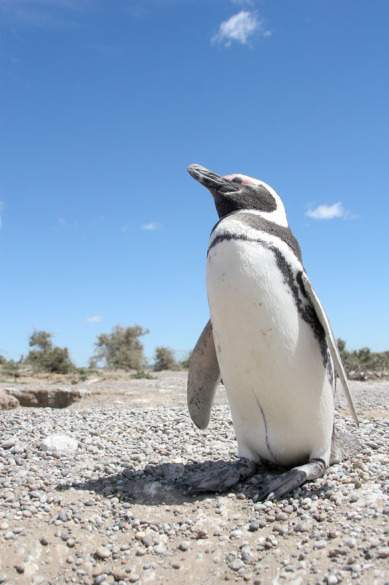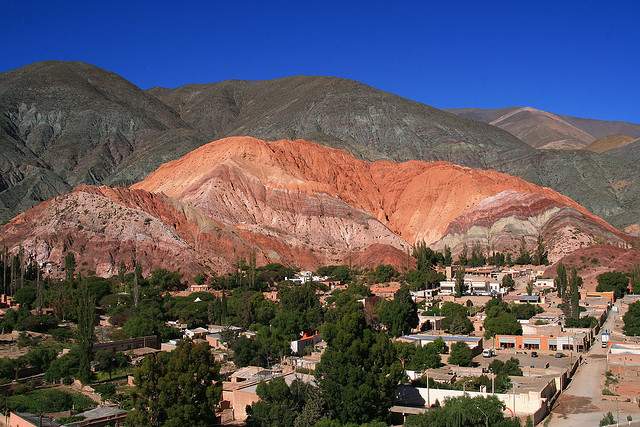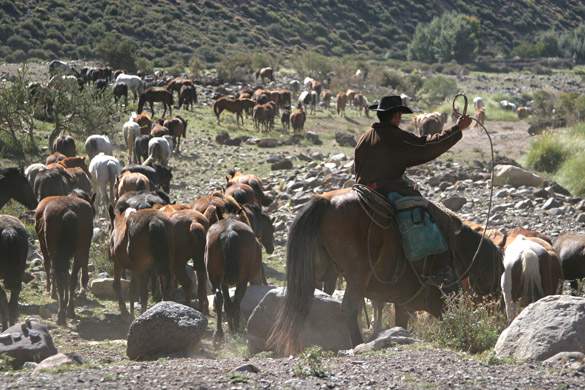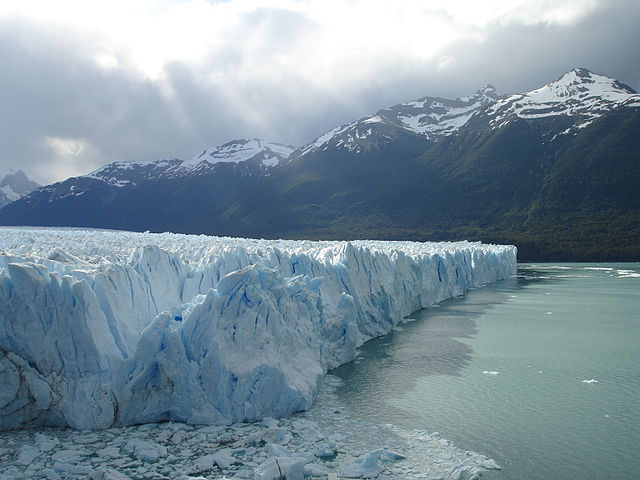Argentina is a a country where just about anything can be found. From a sultry tango on a bustling street in Buenos Aires to the enormous whip-cracking sound of a house-sized chunk of ice falling from a glacier in Patagonia, Argentina is a land with something for everyone. Finding a variety of things to see and do isn’t hard either. With the country’s wide array of gorgeous landscapes and cultural experiences, a new and unique adventure is always just a bus ride away. Here are a few, but not nearly all, of the variety of experiences and places that can be enjoyed in this amazing land.
Tango, Buenos Aires

The tango is a gorgeous symbol of Argentina and the passion of its people. The dance has become almost a cliché, but still to see it in motion surrounded by the brightly-painted pastel buildings of the La Boca district of Buenos Aires is a truly unique and beautiful experience.
[social]
While seeing the passionate dance done by veteran Argentine dancers is awe-inspiring, to truly appreciate the difficulty of tango you may want to try it yourself. A fun and more authentic way to catch the first few movements of this fluid dance is to go to a tango club. If you hit one of these on the right night you will be able to get a short lesson, which will be followed by free dance time. If you are not an experienced tango dancer, this is probably just a good time to observe real Porteños (people from Buenos Aires) in the throes of a dance just between two people and not for an audience. However, if you would like to learn more of the dance and get a little time to practice there are also full classes available all over the city.
Just to observe the dance at its highest and most entertaining level one can’t miss the opportunity to see a live tango show. These shows range from glitzy stage performances with props and a story-line to more simple dances in restaurant basements. One of the longest running and best shows is at the Buenos Aires institution Café Tortoni. Here you can catch a tango show with an old world ambiance in the dimly lit brick basement after a meal at the classic eatery.
Check out our Buenos Aires Indie Travel Guide and find a flight to Buenos Aires
Penguins, Punta Tombo

Somewhere around the middle of September every year a small desolate strip of rocky terrain along the south-east coast of Argentina turns into one of the world’s most amazing breeding grounds. It starts with the arrival about 400,000 Magellanic penguins at Punta Tombo Wildlife Reserve and ends when the waddling tuxedo-clad creatures return to the sea to feed for the next four months.
Punta Tombo, being the world largest Magellanic penguin colony, was designated as a fauna reserve by the province of Chubut in 1979, and this puts restrictions on where the visitor can travel. These restrictions should be strictly observed as they are there to protect the penguins, and the visitors, as the penguins are notoriously protective of their young. Despite the restrictions, this amazing reserve will give you a once in a lifetime chance to not only see thousands of the adorable water-birds, but to actually get very close to them as they waddle right across the path on their way down to the sea.
The thin peninsula is also home to a variety of other wildlife, from the llama-like guanaco to the cormorant. In fact the entire area is full of interesting wildlife including Right and Orca whales as well as sea lions and dolphins. This makes a visit to Punta Tombo not only unforgettable, but also possibly part of a larger Argentine safari.
Going to see the world’s largest Magellanic penguin colony is surprisingly easy as Punta Tombo lies only 110 km from the city of Trelew and only 180 km from the major beach town of Puerto Madryn. This means that it is easy to book a tour from the town. If you would like to see the penguins on your own schedule and have your own transport, you can follow the paved Route 3 south from Puerto Madryn until Trelew where you change onto the small provincial Route 1. This is the unpaved section that brings you to the reserve, which can be impassable in bad weather – so check ahead of time.
Hill of Seven Colors

The Cerro de Siete Colores (Hill of Seven Colours) in the small town of Purmamarca is one of the most spectacular examples of the amazing geological sites along the Quebrada de Humahuaca (Humahuaca Canyon). This canyon, which follows the Rio Grande, is characterized by the mineral-rich hillsides that have made it an other-worldly landscape splashed with bright earth hues – ranging from deep reds to greens and even bright oranges. The drive along Route 9 through the quebrada between the towns of Purmamarca and Humahuaca is surrounded by some of the area’s most impressive beauty. The trip isn’t a hard one to make, either, as there are frequent buses coming from the provincial capital, Jujuy. However, a nice alternative to allow for photo stops is renting a car in Jujuy.
Although it is the natural beauty that draws most of the visitors to the area, it is of cultural interest as well. There is a strong influence from the many indigenous people that have called the region home for thousands of years. The cultural traditions of these people have been well-preserved and are very visible in the markets and adobe-style houses of the region. There are even white adobe churches more commonly associated with the highlands of Bolivia and Peru.
Find a flight to Jujuy
Gauchos

A dusty path in the blazing sun in the mountains of central Argentina – and around a bend comes the first of an extended line of horses. They plod along, some stopping to eat the grass at the side of the road. The last three horses to come around the bend are carrying three sun-soaked men wearing large round hats with folded edges, their baggy pants straddling the saddle. They shout at the horses and keep them moving down the trail toward the river. These are gauchos, Argentina’s answer to North America’s cowboys.
Examples of this fascinating culture can be found throughout the country in nearly any rural area, but one town is especially known for its gauchos. San Antonio de Areco sits in the rolling pampas about 113 km north west of Buenos Aires. One of the main reasons for its distinction as the gaucho capital of Argentina is the fact that one of the country’s most famous gaucho tales, Don Segundo Sombra, was set in the town, and the author Ricardo Güraldes called the town his home. There is also a annual festival, the día de la tradición, which celebrates all the parts of the gaucho lifestyle which are enjoyed by Argentine people to this day. Although San Antonio de Areco may be the recognized gaucho culture centre of Argentina, examples of it can be found in every part of Argentine life.
One of the most important influences that gauchos have had on Argentina is the effect they have had on Argentine cooking and diet. Barbecued meat isn’t only a major part of the average Argentinean’s diet, but the barbecue, or asado, is an important part of the social fabric for most people.
Find a hostel in San Antonio de Areco
Perito Moreno Glacier

One of Argentina’s single most incredible natural wonders is is Perito Moreno Glacier, in the southern Patagonian province of Santa Cruz. The sight of this craggy ice wall rising 74 metres out of the water of Lake Argentino is truly awe-inspiring. This huge wall only shows about one-seventh of the actual height of the glacier as the rest is below the waterline.
This wall is the front line of one of the world’s few advancing glaciers and is followed by the massive ice flow that stretches 30 km back to the enormous South Patagonian Ice Field. The whole glacier covers an area of over 257 square km. With such a mass of advancing ice it is not rare to see huge chunks of ice (some the size of houses) begin to crack off the mass, sending booming gunshot sounds across the lake, followed by an eruption of water as the chunk splashes down.
Perito Moreno Glacier is only one of 48 glaciers that flow from the South Patagonian Ice Field, but it is definitely the most easily accessible. Countless buses run daily from the nearby tourist centre of El Calafate. These take you to the Los Glaciares National Park with a stop at a boat dock, where you have the opportunity to take a short boat trip to see the glacier from the water level. From there you will be dropped at the main visitor centre where you can set out on the winding series of boardwalks and staircases that allow you to see the glacier from many angles.
Los Glaciares National Park was named a UNESCO World Heritage site in 1981 and remains one of Argentina’s most important and impressive natural wonders. For the closest possible look at the glacier ice walks are offered, which take you on a short guided tour around one portion of the glacier.
El Chalten

The rugged and jagged peaks of the Fitz Roy range surround the small town of El Chalten, Argentina and make the developing tourist town an amazing place for Argentina’s outdoorsy visitors. The sight of the Torre and Fitz Roy peaks rising sharply above the surrounding hills can be seen from many places in the town. These two peaks, some of the most impressive and recognizable in Argentina, are accessible by beautiful day hikes that start at the outskirts of the town.
The town itself holds its own charms, but it’s growing fast and will probably be more developed by the time you read this article. You can still make your way around town without having the gorgeous mountain surroundings obscured by high-rise hotels, and hopefully it stays this way. There are definitely enough amenities for any independent traveler to be very comfortable, although at this point they are all in their early stages of development. Still, the parks administration office in the town has helpful information and can give you simple maps.
In addition to the two major mountains of the area there are countless other day hikes, multi-day camping excursions, or full rock climbs you can embark on using the small town as your base.
Read 10 Awesome Treks that Almost Anyone Can Do
Lake District

One of Argentina’s biggest draws for its own people is the stunning lake district. This area, stretching along the western border with Chile, boasts some pristine mountain wilderness and incredible, clear lakes.
Many of Argentina’s own tourists flock to Bariloche around holiday times for its ski slopes, lake side scenery, and European chocolate, all within a well-established tourism infrastructure. Bariloche is also the best place to get all the information and gear needed to start out into the back-country of Nahuel Haupi National Park, which encompasses much of the lake district. The park is home to day hikes and multi-day trips that can take hikers to remote lakes, mountains, or some of the parks snow-capped volcanoes.
For those looking for a spot in the lake district that doesn’t require days of hiking – but still isn’t a tourism Mecca – there are still plenty of options. The quaint towns of San Martín de los Andes, El Bolsón, and Villa la Angostura all offer different options. From the upscale lakeside beauty and European-inspired architecture of San Martín to the fun and whacky hippie market of El Bolsón, there are so many options of things to do and see in this highlight of Argentina.
The Friendliest People on Earth

Although it is the bounty of natural and cultural sites that will attract you to this diverse and beautiful land, it will be the endless kindness of the people that will make you want to stay forever.
Whether you are looking confused on a busy street corner in Buenos Aires or fumbling through a Spanish sentence in a small town market, the people of Argentina are incredibly patient and friendly and you will be amazed at how far they will go out of their way to help. Not only will the locals’ helpful nature be a big aid when you are lost or puzzled, but the passion of the Argentine people is what makes them even more alluring. This passion comes through in every facet of life – boisterous dinners starting just before midnight, the love of dance, food, wine, and most of all fútbol (football, soccer).
Whatever it is that brings you to Argentina there will be many, many reasons that you will want to stay. To any visitor who spends some time it becomes obvious that Argentina is so much more than its obvious, world-class sites it is about the amazing experiences to be had and the incredible people that you will encounter along the way. It is this mix of sites, experiences, people, and of course the food and drink that make Argentina one of the world’s most amazing places to visit. Once you spend a little time you will realize that no amount of time will ever feel like enough.
Ready to go? Check out this multi-stop trip that includes Argentina, and learn more about South America in the following resources:
- Read about why you should add Argentina to your multi-stop trip
- Read How to Plan an Extended Trip in South America
- Places in South America to Escape the North American Winter
- 5 Countries to Visit for Under $500
- Exciting Edibles in South America
- Wine Tasting in South America: Where to Go and What to Try
Photo credits: Tannenhaus, Robert Scott Flaum, Nestor Galena, Yoavlevy10, all other photos by Brendan Nogue and may not be used without permission
